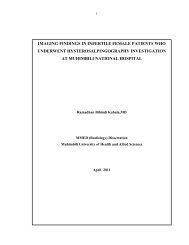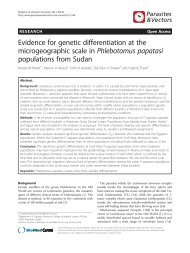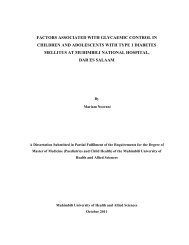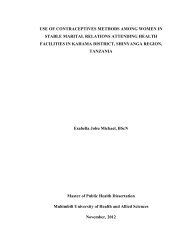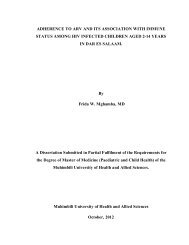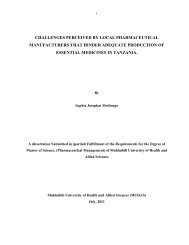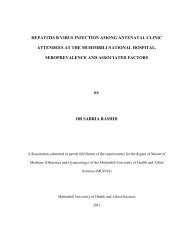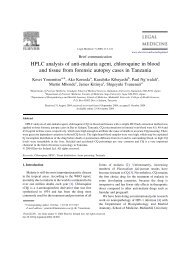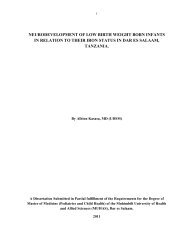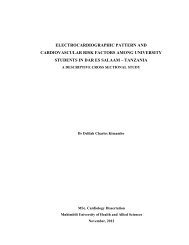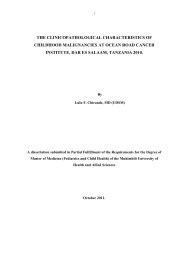DISSERTATION WORK MSAFIRI KABULWA.pdf
DISSERTATION WORK MSAFIRI KABULWA.pdf
DISSERTATION WORK MSAFIRI KABULWA.pdf
Create successful ePaper yourself
Turn your PDF publications into a flip-book with our unique Google optimized e-Paper software.
42<br />
smoked (4.4%) indicate that smoking cigarettes is practiced by some of the secondary school<br />
students. The reported prevalence of ever smoked (4.4%) in the current study is higher than<br />
that reported by Kaaya et al 1991 (1.0%) but similar to the reported prevalence of 5.9% by<br />
Kaduri et al (2008). These findings indicate an upward trend of smoking habit among<br />
adolescents in Dar es Salaam. The proportion of students who have ever smoked cigarettes in<br />
the present study is lower than that reported in Kenya, Uganda and Ivory Coast where the<br />
prevalence were 31.0%, 17.5% and 15.3% respectively (Ogwell et al 2003, Mpabulungi and<br />
Muula 2004, Siziya et al 2007c).<br />
The prevalence of 2.2% for students who ever dipped and 4.4% for students who ever chewed<br />
or smoked is not to be ignored first because these percentages would translate to big numbers<br />
given the fact that there were 157764 ordinary level secondary school students in Dar es<br />
Salaam at the time of the study. Secondly these students are likely to influence others to dip,<br />
chew or smoke tobacco (Kwamanga et al 2003, Islam and Johnson 2005, Siziya et al 2007b,<br />
Rudatsikira et al 2007, Muula et al 2008, Odeyemi et al 2009). Thirdly they have an increased<br />
risk of about 4 times of developing oral cancer and periodontal disease (Blot et al 1988, Tomar<br />
and Asma 2000). Therefore intervention against this habit at an early age is essential to prevent<br />
the potential of influencing others to start smoking and to reduce the risk of acquiring oral<br />
cancer and periodontal disease.<br />
9.2 Knowledge on detrimental effects of tobacco use on health<br />
Majority of students who participated in this study (96.8%) were knowledgeable on the<br />
relationship between smoking cigarettes as cause of systemic diseases. This is encouraging<br />
because knowledge of detrimental effects of tobacco use has been shown to be a deterrent for<br />
tobacco use (Nourjal et al 1994). Therefore, this higher level of knowledge on adverse effects<br />
of cigarettes smoking on systemic diseases may be one of the reasons for low prevalence of<br />
tobacco use in the current study.<br />
The findings of the present study are similar to that reported in the United States (Siahpush et<br />
al 2006), Great Britain (Terrades et al 2009) and Australia (Rikard-Bell et al 2003) among<br />
adults where the proportion of respondents knowledgeable on cigarettes smoking as cause of



